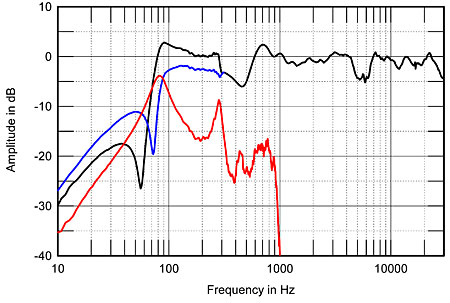| Columns Retired Columns & Blogs |
Fried Compact 7 loudspeaker Second Sample Measurements
Sidebar: Sample 2 Measurements
In the October issue (p.46), columnist John Marks was disappointed with the sound of Fried Products' Compact 7 two-way, stand-mounted loudspeaker ($1795/pair). It turned out, as I reported in that issue's "Follow-Up" section (p.184), that the woofers of both samples of the pair (S/Ns D50057 & '58) had been wired in the wrong polarity, which Fried's David Finley confirmed in his "Manufacturer's Comment" (p.201). We asked Mr. Finley to send us a second, correctly assembled pair for Follow-Up coverage in this issue; John discusses their sound in his column. But before shipping them to him, I performed a full set of measurements on both samples (S/Ns DF0061 & '62).

Fig.1 Fried Compact 7, step response on listening axis at 50" of old sample (red) and new sample (blue). (5ms time window, 30kHz bandwidth.)
This time, the woofers were correctly wired. The blue trace in fig.1 shows the step response of the new Compact 7 on the listening axis. The sharp positive-going spike at 3.7ms is the tweeter's output, which blends smoothly into the negative-going step of the woofer. The red trace in this graph shows the step response of one of the first samples; both drive-units are connected with the same, positive-going polarity, which results in an enormous suckout in the frequency region in which these outputs overlap (fig.2, red trace).

Fig.2 Fried Compact 7, anechoic response on listening axis at 50" without grille, averaged across 30° horizontal window and corrected for microphone response, of old sample (red) and new sample (blue), with the complex sum of the nearfield woofer and port responses of each plotted below 300Hz.
By contrast, the opposite-polarity connection of the drive-units in the new sample results in a smooth, even frequency response in the same region (fig.2, blue trace), though there is now a small suckout evident between 5 and 7kHz. The level of the tweeter in this new sample also appears to have been increased by 3dB, perhaps to address JM's criticism of the earlier samples not having a particularly extended HF region. The large suckout in the lower midrange remains unchanged, however, as does the sharp rolloff below 75Hz or so.

Fig.3 Fried Compact 7 (sample 2), anechoic response on listening axis at 50" without grille (black), averaged across 30° horizontal window and corrected for microphone response, with the nearfield responses of the woofer (blue) and port (red), plotted in the ratios of the square roots of their radiating areas below 350Hz and 1kHz, respectively, and the complex sum of the nearfield responses plotted below 350Hz (black).
The blue and red traces in fig.3 show the individual outputs of the woofer and port, respectively, measured in the nearfield. Although Fried refers to the Compact 7 as a "line tunnel," the speaker is really a reflex design, with a nominal port tuning frequency of 70Hz, the frequency of the minimum-motion notch in the woofer's response. The port's output actually peaks a little higher in frequency, however, which results in an overall LF response that rolls off more rapidly than in a typical reflex design, with then a notch in the midbass. What can also be seen in fig.3 is a very high resonant peak at 290Hz in the port's output. In fact, this port resonance is so high in level that it results in a distinct step in the summed LF response at its center frequency (fig.3, black trace), and probably contributes to the speaker's relative lack of energy in the octave between 300 and 600Hz. In this respect, the new sample behaved almost identically to the first—behavior that, I feel, contributed to JM finding the speaker's balance "entirely too tailored and polite."

Fig.4 Fried Compact 7 (sample 2), cumulative spectral-decay plot on listening axis at 50" (0.15ms risetime).
This lack of lower-midrange energy is hinted at in the Compact 7's cumulative spectral-decay plot (fig.4), though unfortunately this graph lacks resolution in this region. The treble region is basically clean, but with some low-level hash evident in the region of the on-axis notch.

Fig.5 Fried Compact 7 (sample 2), electrical impedance (solid) and phase (dashed). (2 ohms/vertical div.)
Finally, while the Fried Compact 7's voltage sensitivity is a high 91.5dB(B)/2.83V/m, its impedance plot (fig.5) indicates that the speaker is really a 4 ohm design. The twin peaks in the bass in this graph also confirm the woofer alignment to be basically a reflex of some kind with a port tuning frequency of 70Hz; the unevenness of the trace at 290Hz confirms the existence of a cabinet resonance at that frequency.
The new samples of the Fried Compact 7 definitely measure better than the first samples, at least in regard to the integration in the treble of the woofer and tweeter outputs, and also demonstrate superb pair matching. But I am still concerned about that odd behavior in the lower midrange, and about what appears to me to be the woofer's suboptimal reflex tuning.—John Atkinson
- Log in or register to post comments




































